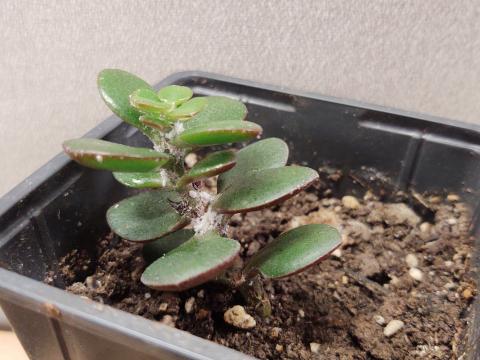How do you get rid of mealybugs on houseplants?

Mealybugs can be incredibly frustrating and difficult to manage. They are primarily an indoor or greenhouse pest in New Hampshire because they cannot survive the winter outside. They are almost always introduced on infested plants that are brought into homes, making it critically important to scrutinize all purchased or gifted plants for pests before bringing them into your house. Once a population is established, it is an uphill battle to eliminate them from your houseplant collection.
Mealybug Identification
There are several species of mealybugs that attack houseplants, but all have similar features that make them easy to recognize. Adult female mealy bugs are oval-shaped, lack wings and are covered with white wax, making them look slightly fuzzy. They have legs and are capable of moving but don’t travel very far or move very quickly. Female nymphs (immature) mealybugs are oval and colored yellow, orange or pink, accumulating fluffy, white wax as they mature. Nymphs that still lack wax are highly mobile and move around on their host plant or spread to other nearby plants. Male mealybugs are very tiny and gnat-like. They have wings to help them get to female mates, but they are seldom noticed while scouting plant foliage.
Mealybug Damage
Mealybugs feed on plant sap with piercing-sucking mouthparts and excrete a sweet, sticky fluid called honeydew. Unsightly black fungus called sooty mold often grows on the honeydew, making the leaves look dirty and reducing photosynthesis. Heavy mealybug infestations can reduce plant vigor and stunt growth. Small populations of mealybugs are often hard to detect because they wedge themselves into crevices such as leaf axils or the bases of stems. However, as their numbers increase, mealybugs of all sizes can be found on all surfaces of plants. A few species feed on plant roots, which can make them even more difficult to detect. Mealybug egg masses are often the easiest thing to spot. The eggs themselves are very small, but they are usually covered with a fluffy, white mass of wax.
Control Options
Because mealybugs are so good at hiding in nooks and crannies, they often go unnoticed until their population has exploded. It is very important to regularly inspect plants for signs of them, paying special attention to leaf axils and stem bases. Mealybugs will feed on a wide variety of houseplants, but tend to prefer coleus, cactus, ferns, hoya, jade, orchids, palms, philodendron, ficus, schefflera and citrus. Carefully scout these plants before bringing them home, and closely monitor them in the subsequent weeks and months. If you discover mealybugs, either quarantine and treat, or toss out that plant. Keeping pest-free plants physically distant from infested ones is the best way to prevent mealybugs from spreading.
It is often best to discard heavily infested plants rather than try to treat them because of how difficult it can be to get rid of them. If your plant is only lightly affected, you can try washing the leaves and stems with a diluted dish detergent and water solution. Use a cloth or a brush to remove both the mealybugs and the honeydew from the leaves. Handpicking or using a cotton swab dipped in alcohol may also be effective. Note that alcohol can damage the foliage of some plants, so it is a good idea to try dabbing a small amount onto a leaf or two a day or so before a complete application to see if there will be a negative reaction. Washing and hand-removal will likely need to be repeated multiple times to eliminate all mealybugs.
If you’re not successful with the above methods, you could consider using an insecticide. The wax on mealybug bodies and around their eggs make them pretty waterproof and resistant to pesticides. They are also very good at hiding in nooks and crannies, allowing them to avoid exposure to sprays and making multiple sprays a necessity. Less toxic options include insecticidal soap, horticultural oil and neem. These active ingredients smother mealybugs by clogging their breathing holes and tend to work best on young nymphs with limited wax on their bodies. They must be applied directly to the insects to work, so aim for good coverage on all plant surfaces including the leaf undersides. Soaps and oils can burn the foliage of some plants, so again, test them on a leaf or two before treating the entire plant. There are also some systemic insecticides that are labelled for houseplants and mealybugs that contain the active ingredient imidacloprid, but these are only recommended for highly valuable plants that cannot easily be replaced.
Do you love learning about stuff like this?
SUBSCRIBE TO GRANITE STATE GARDENING
A monthly newsletter for New Hampshire gardeners, homesteaders and plant-lovers of all kinds, that includes seasonal suggested gardening tips, upcoming events and articles with proven solutions for your garden and landscape.
Got questions? The Ask UNH Extension Infoline offers practical help finding answers for your home, yard, and garden questions. Call toll free at 1-877-398-4769, Monday to Friday, 9 a.m. to 2 p.m., or e-mail us at answers@unh.edu.
